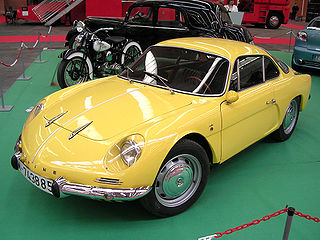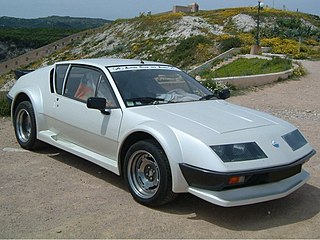 W
WThe Alpine A106 was the first of a line of light-weight glass-fibre bodied, rear-engined two-door coupés produced for a young competition-oriented Dieppe based Renault dealer called Jean Rédélé. The car was based on mechanical components from the Renault 4CV.
 W
WThe Alpine A108 was a light-weight glass-fibre bodied, rear-engined two-door coupé produced for a young competition-oriented Dieppe based Renault dealer called Jean Rédélé. The car replaced the Alpine A106 and was based on mechanical components from the Renault Dauphine.
 W
WThe Alpine A110 is a sports car produced by French automobile manufacturer Alpine from 1961 to 1977. The car was styled as a "berlinette", which in the post-WWII era refers to a small enclosed two-door berline, better-known as a coupé. The Alpine A110 succeeded the earlier A108. The car was powered by a succession of Renault engines. A continuation of the A110, developed under Renault-Nissan partnership, was introduced in 2017.
 W
WThe Alpine A110 is a rear mid-engine, rear-wheel-drive sports car introduced by French car manufacturer Alpine at the 87th Geneva International Motor Show in March 2017.
 W
WThe Alpine A210 was a sports car prototype manufactured by Alpine that competed in sports car racing from 1966 to 1969. The car derived from the M series prototypes introduced by the company in the early 1960s and powered by Gordini-tuned Renault engines with small displacements. In 1967, a short-lived V8-powered version of the A210, named as A211, was introduced. A major redesign of the A211, the A220, was unveiled the following year. As a consequence of the bad results achieved by these last two cars, Alpine withdrew from sports car racing for various years.
 W
WThe Alpine A210 was a sports car prototype manufactured by Alpine that competed in sports car racing from 1966 to 1969. The car derived from the M series prototypes introduced by the company in the early 1960s and powered by Gordini-tuned Renault engines with small displacements. In 1967, a short-lived V8-powered version of the A210, named as A211, was introduced. A major redesign of the A211, the A220, was unveiled the following year. As a consequence of the bad results achieved by these last two cars, Alpine withdrew from sports car racing for various years.
 W
WThe Alpine A210 was a sports car prototype manufactured by Alpine that competed in sports car racing from 1966 to 1969. The car derived from the M series prototypes introduced by the company in the early 1960s and powered by Gordini-tuned Renault engines with small displacements. In 1967, a short-lived V8-powered version of the A210, named as A211, was introduced. A major redesign of the A211, the A220, was unveiled the following year. As a consequence of the bad results achieved by these last two cars, Alpine withdrew from sports car racing for various years.
 W
WThe Alpine A310 is a sports car built by French manufacturer Alpine, from 1971 to 1984.
 W
WThe Alpine A110-50 is a concept racing car created by Renault to commemorate the 50th anniversary of the 1962 Alpine A110 It debuted at Monaco's GP circuit, where Renault Chief Operating Officer Carlos Tavares raced the A110-50 for four laps of the Monaco track.
 W
WThe Alpine A210 was a sports car prototype manufactured by Alpine that competed in sports car racing from 1966 to 1969. The car derived from the M series prototypes introduced by the company in the early 1960s and powered by Gordini-tuned Renault engines with small displacements. In 1967, a short-lived V8-powered version of the A210, named as A211, was introduced. A major redesign of the A211, the A220, was unveiled the following year. As a consequence of the bad results achieved by these last two cars, Alpine withdrew from sports car racing for various years.
 W
WThe Alpine A210 was a sports car prototype manufactured by Alpine that competed in sports car racing from 1966 to 1969. The car derived from the M series prototypes introduced by the company in the early 1960s and powered by Gordini-tuned Renault engines with small displacements. In 1967, a short-lived V8-powered version of the A210, named as A211, was introduced. A major redesign of the A211, the A220, was unveiled the following year. As a consequence of the bad results achieved by these last two cars, Alpine withdrew from sports car racing for various years.
 W
WThe Alpine A210 was a sports car prototype manufactured by Alpine that competed in sports car racing from 1966 to 1969. The car derived from the M series prototypes introduced by the company in the early 1960s and powered by Gordini-tuned Renault engines with small displacements. In 1967, a short-lived V8-powered version of the A210, named as A211, was introduced. A major redesign of the A211, the A220, was unveiled the following year. As a consequence of the bad results achieved by these last two cars, Alpine withdrew from sports car racing for various years.
 W
WThe Renault Alpine A442 is a sports prototype racing car, designed and built by Alpine, but funded and powered by Alpine's owners Renault, specifically to contest the 24 Hours of Le Mans race. Variants were entered for the event in 1976, 1977 and 1978. An A442B finally won the race on the third occasion, in the hands of Didier Pironi and Jean-Pierre Jaussaud. Also entered in 1978 was the updated Renault Alpine A443 model; essentially an A442 chassis, but powered by a new 2138 cc engine. Following this all-French victory in the premier French motorsport event, Renault withdrew from sports car racing to concentrate their efforts in Formula One.